In the days following the U.S. bombing of Iranian nuclear test sides, reports indicated the sites were severely damaged but not totally destroyed. Experts point out that nuclear bombs are based on 80-year-old technology and Iran still has the knowledge and means to build new enrichment centrifuges.
Uriel Abulof, a visiting professor in Cornell University’s government department and a professor of politics at Tel-Aviv University, published a case study in the journal Politics and Policy: "Nuclear Diversion Theory and Legitimacy Crisis: The Case of Iran."
Abulof says: “In the aftermath of recent regional escalations, there’s a growing risk of repeating a familiar—and dangerous—pattern: ceasefire, self-congratulation, and strategic blindness. Iran’s leadership, emboldened by survival rather than victory, may be quietly advancing toward a nuclear breakout under the radar.
“A messianic Iranian regime under siege, armed with just enough nuclear capability to be dangerous, is the darkest kind of threat. With only 50 advanced centrifuges (IR-6), Iran could enrich 50–60 kg of uranium from 60% to weapons-grade (90%) within weeks—enough for a basic atomic bomb. That bomb wouldn’t need to be launched on a missile. It could be assembled covertly, without a nuclear test, and delivered in a truck or a shipping container."




